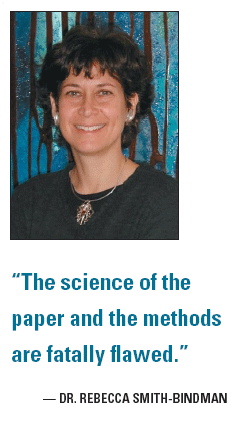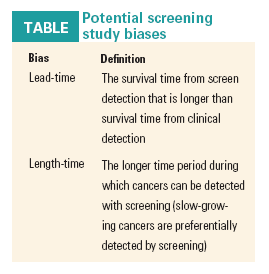Study of mammography in older women stirs up controversy
A recent study in elderly breast cancer patients that linked earlier-stage disease, and possibly improved survival, with regular screening mammography is “fatally flawed” and “naïve,” according to some cancer screening experts.
A recent study in elderly breast cancer patients that linked earlier-stage disease, and possibly improved survival, with regular screening mammography is “fatally flawed” and “nave,” according to some cancer screening experts. But the authors maintain that their results offer insights into a patient population that is generally underserved.
While the critics stressed that the topic of breast cancer screening in women aged 80 and older is an important one, they also worried that the study by Gildy Babiera, MD, and colleagues from M.D. Anderson Cancer Center may promote overdiagnosis and unnecessary treatment.

“The science of the paper and the methods are fatally flawed,” said Rebecca Smith-Bindman, MD, associate professor in residence, Department of Radiology, University of California, San Francisco. “This research doesn’t contribute at all in terms of showing a decrease in death or an increase in survival.”
Study protocol
Dr. Babiera’s group reviewed records of 12,358 women, aged 80 and older, from the SEER-Medicare-linked database. All had been diagnosed with, and treated for, breast cancer between 1996 and 2002. (J Clin Oncol online, April 21, 2008).
The results showed that 27% of the women aged 80 to 84 years underwent regular mammography. The mean tumor size for these women was 2.90 cm vs 5.22 cm in nonusers of mammography. Regular screening participants also had fewer positive lymph nodes at surgery and were more likely to undergo breast-conserving surgery and radiotherapy. Nonusers of mammography had higher comorbidity scores, the authors wrote.
Based on multivariate analysis, “each mammogram obtained results in a 37% decrease in risk of late-stage cancer,” Dr. Babiera’s group wrote. “Breast cancer–specific 5-year survival among nonusers was 82%, that among irregular users was 88%, and that among regular users was 94%.”
The group concluded that regular screening in elderly women was associated with detection of earlier-stage disease. They also acknowledged that improved survival was difficult to demonstrate: Survival from causes other than breast cancer was also associated with mammography use, “suggesting a bias for healthier patients to undergo mammography,” the study investigators wrote.
“This study is just flat-out wrong. It is nave, and it provides no evidence whatsoever that there is a benefit for screening women in their 80s. It doesn’t provide positive evidence; it doesn’t provide negative evidence,” said Donald Berry, PhD, chairman, Department of Biostatistics at M.D. Anderson Cancer Center.
But not everyone is as dismissive of the results. “This is a good study for clinicians to recognize that there is certainly a role for continued mammography screening in this age group,” said Karen Lane, MD, clinical director of the University of California, Irvine, Breast Health Center.
The critics charge that Dr. Babiera’s group failed to account for the two major limits of screening trials: lead-time bias and length-time bias (see Table). When a screening study doesn’t address these biases, results are bound to be rosier, Dr. Berry said, with screening turning in an artificially positive performance.

To complicate matters, lead-time bias is difficult to pin down, especially in older women. Previous mammographic screening studies have focused on younger women, and even then, lead-time bias has proved slippery, Dr. Berry pointed out.
“The problem is that we don’t know what the lead-time bias is except that it’s huge,” he said. “That’s the reason we did randomized clinical trials because we couldn’t address the question by looking at clinical practice. Moreover, whatever the lead-time bias is for younger women, it’s different for older women. We have almost no information about that, but I expect that the lead time is greater in older women than in younger women.”
In an M.D. Anderson news release of April 21, Dr. Babiera and co-author Brian Badgwell, MD, said they recognized that “finding breast cancer early in this age group may not result in survival benefit and it may even increase unnecessary angst in elderly women with other ailments.”
Nonetheless, they reiterated in the written statement that finding these cancers early through routine screening may guide elderly women in good health to less invasive and toxic treatment options.
But prior observational studies that have taken lead-time bias into account did not show a significant increase in mortality benefits from screening, said Mara Schonberg, MD, MPH, of Harvard Medical School. “This study only addressed the potential benefits of screening and did not consider any of the risks,” Dr. Schonberg said. “Also, by excluding women with a history of other cancers and whose tumors were unstaged or not histologically confirmed, this study examined a healthier population of women aged 80 and older than the general population.”
For Dr. Lane, the exclusion of lead-time and length-time bias was not a problem. Given that randomized controlled studies will never be conducted in this patient population, database studies are the best bet for advancing knowledge on breast health in older women, she said.
“I think these database studies supply us with the best information for a very large number of women, and we just have to deal with whatever shortcomings database work might present to us,” Dr. Lane said. “This type of work does help us start thinking about the appropriate screening schedule in this population.”
In their paper, Dr. Babiera’s group said that a selection bias was possible because healthier women were more apt to comply with regular screening guidelines. This self-selection is not a minor point, said Robert Kaplan, PhD, of the UCLA School of Public Health.
“It is not possible to determine whether mammography extends life from this type of study. The study is observational and there is clearly self-selection into screening by more affluent and healthier women,” he said.
A similar bias led the healthcare community to believe that hormone replacement therapy was beneficial to postmenopausal women until randomized trials proved otherwise, he added.
Dr. Babiera responds
In correspondence with ONI, Dr. Babiera noted that her study explored a common “real life clinical situation” that presents a real dilemma for clinicians and patients. She argued that clinicians have a responsibility to discuss her group’s study results with their elderly patients. Information from her study “may be useful, as women in this country are living longer and healthier lives,” she said. “Earlier diagnosis of disease may allow for less aggressive therapies that can have a profound impact on quality of life and potentially on utilization of resources.”
She argued that it is the responsibility of clinicians to advise patients on all clinical studies, randomized or not. “There is no class I evidence (randomized trials) addressing this issue in the elderly, and it is unlikely such a study will be done,” she said, while expressing the hope that the current controversy may encourage the development and implementation of such trials.
Newsletter
Stay up to date on recent advances in the multidisciplinary approach to cancer.